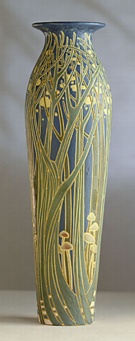
Examples:

Greek, Attic, attributed to Oltos, Psykter, c. 520-510 BCE,
Archaic, red-figure, terra cotta, height
11 7/8 inches (30.20 cm), Metropolitan Museum of Art, NY. A psyker is a Greek vase for
cooling wine when it is partly submerged inside of a krater
filled with icey water.

Among the types of Greek vases are the amphora, panathenaic amphora, hydria, pelike, volute and calyx kraters, lekythos, and kylix. Also see kantharos.
![]()
Greece, Apulia, South Italy, attributed
to the Painter of Louvre MNB 1148, about 330 BCE,
Red-Figure Loutrophoros (Type I) with Ovoid Body,
terra cotta, height
35 1/2 inches, diameter (rim) 10 1/2 inches (h. 90.1 cm, d. 26.0
cm), J. Paul Getty Museum, Malibu, CA.

Japan, "Sue Potter," Kofun
Period, 7th century, Tall-necked vase, excavated
from Kaniana Tumulus, Toba-shi, Mie, glazed
pottery, height
55.7, mouth diameter 24.0
cm, Tokyo National Museum. Japanese authorities consider this
to be an "Important Cultural Property." See Japanese art.
![]()
![]()
Dutch, Delft Vase, 1700-1725, ceramic, Minneapolis Institute of Arts.
See cobalt.

Nicholas Lecroux (Belgium, Tournay, 1733-99), Pair of Potpourri Vases, c. 1760, porcelain, height 9 inches (22.9 cm), Los Angeles County Museum of Art.

France, Sèvres, Royal Porcelain Factory,
about 1769, Pair of Lidded Vases, painted reserves
attributed to Jean-Baptiste-Etienne Genest, porcelain painter,
soft-paste porcelain,
blue Fallot ground, gilding, gilt-bronze mounts, 3 feet 6 1/4
x 3 feet 3 3/4 x 1 foot 2 inches (107.3 x 101 x 35.5 cm), J.
Paul Getty Museum, Malibu, CA. See French
art.

John Bennett (American, 1840-1907, New York,
NY), Vase, 1882, earthenware, 11 inches x 11 inches (27.9 x
27.9 cm), Metropolitan Museum of Art, NY.

Attributed to George Prentiss Kendrick (United States, 1850-1919), Handled Vase, 1898-1902, stoneware, glaze, height 11 inches (27.94 cm), diameter 9 1/4 inches (23.5 cm), Los Angeles County Museum of Art. See Art Nouveau.

George Edgar Ohr (American, 1857-1918), Vase, c. 1888-1894, earthenware, height 7 1/4 inches (18.42 cm), diameter 4 7/8 inches (12.38 cm), Los Angeles County Museum of Art.

Frank Lloyd Wright (American, 1867-1959) designer, James A. Miller and Brother, fabricators, Weed Vase, designed c. 1893, fabricated c. 1898, copper, 29 1/2 x 4 1/8 x 4 1/8 inches (74.93 x 10.48 x 10.48 cm), Los Angeles County Museum of Art.

University City Pottery (United States, 1909-1915), Frederick Hurten Rhead (American, born England, 1880-1942), Vase, 1911, earthenware, 17 1/4 x 5 1/8 inches (43.82 x 13.02 cm), Los Angeles County Museum of Art.

Dante Marioni (American, Seattle, 1964-),
Yellow Leaf Vase, 1994, glass,
32 1/4 x 7 1/2 x 2 1/4 inches, diameter
[foot] 6 inches (80.6 x 18.8 x 5.6 cm, diameter
[foot] 15 cm), Cincinnati Art Museum, OH.
Vases were of great importance in ancient Greece, made in numerous conventional shapes, each designed for a specific function, these designs standardized in to varying degrees, many variations depending on the period and region in which it was produced. The names of vase shapes include: alabastron, amphora, askos, cantharus, hydria, kiathos, krater, kylix, lagynos, lekythos [or lecythus], loutrophoros, oinochoe, olpe, pithos, psyker, pyxis, rhyton, skyphos, and stamnos.
https://inform.quest/_art